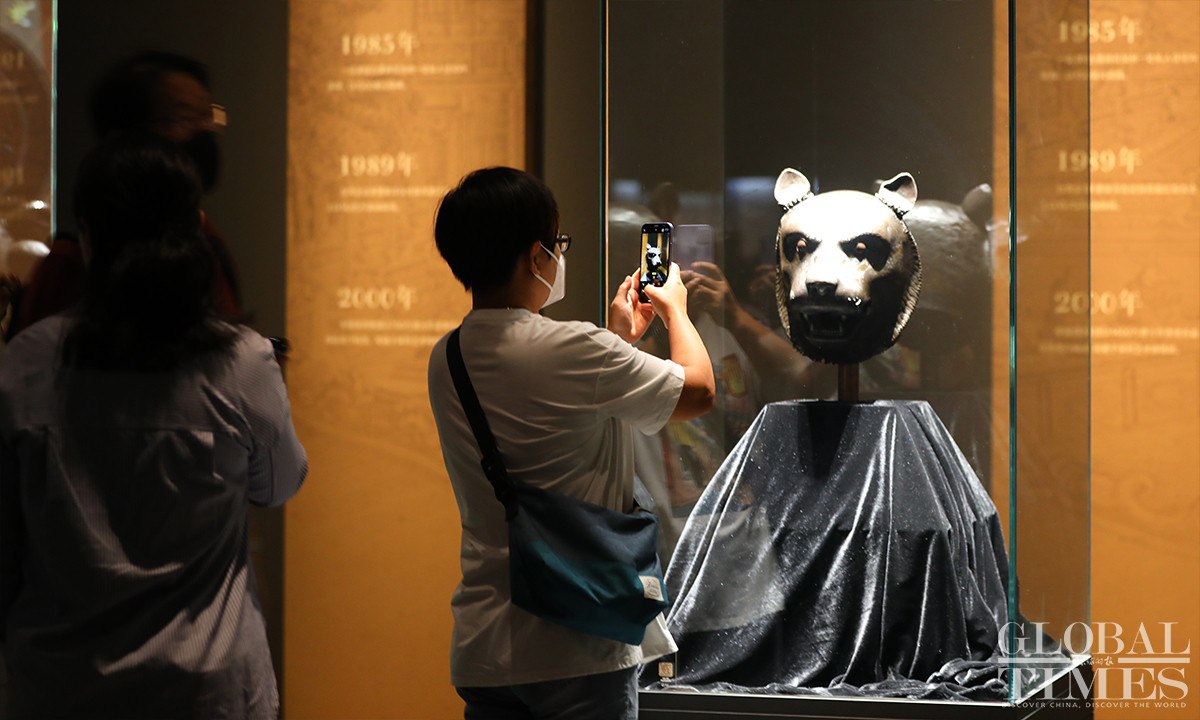Photo: Chen Xia/GT
Once lost overseas and thought gone forever, five heads stolen from a set of bronze Chinese zodiac statues are now on display in Shanghai at a “sold-out” exhibition that has become a phenomenon in the city ahead of the upcoming National Day holidays starting on Saturday.
The exhibition, which opened on Monday at the Minhang Museum, puts on display a total of 47 national treasures that had once been lost overseas, so that they and their tortuous lost-and-found stories can be appreciated by visitors. The heads were originally part of an 18th century water clock fountain in Beijing’s Yuanmingyuan, or the Old Summer Palace, that included 12 statues modeled after the Chinese zodiac.
The fountainheads were ripped from their statues when the Old Summer Palace was razed by British and French forces during the Second Opium War in 1860.
Over the years, through the efforts of philanthropists and organizations, seven of the fountainheads have been returned to China.
The fountainheads are rarely put on display outside the capital, which has promoted the popularity of the current exhibition.
“We wanted to create the opportunity to reunite these animal heads in front of people in modern times. When visitors see the scratches on them, they can empathize with the misery of China during that period of time… I think this is a chance for all of us to understand history from a whole new angle,” Xu Di, director of publicity at the museum, told the Global Times on Wednesday.
Reproduction

The Yuanmingyuan Park in Beijing was burned and ransacked by British and French troops, while the Anglo-French expedition force invaded China during the Second Opium War in 1860. Photo: VCG
In A Story of the Old Summer Palace published by the Palace Museum in 2017, author Liu Yang presented an all-round review of the Haiyan Hall, a famous Western-style building in Yuanmingyuan, destroyed by the British and French forces during the Second Opium War in 1860.
The main entrance of this luxurious building faced to the west and there were stone steps on both sides leading to the second floor. The fountain pool in front of the hall was in the shape of a diamond, with bronze statues of the Chinese zodiac lined up alongside it.
“Each bronze statue would spray water out of its mouth for two hours following a time sequence, and at midday all the bronze statues would spray water together. People could tell the time according to the statutes, so they were also known as a ‘water-powered clock,'” Liu wrote in the book.
The 12 bronze animal heads, with selected materials, ingenious shape, and skillful craftsmanship combined ancient oriental time counting and the Chinese zodiac with Western-style fountains, and they were a perfect blend of Chinese and Western cultures.
After the destruction, the international community, including the French Romantic writer and politician Victor-Marie Hugo, condemned the barbaric act by the British and French.
However, the recovery of the looted cultural relics still faces a bumpy road ahead.
“There are at least 1.5 million Yuanmingyuan cultural relics scattered at home and abroad. Recovery is still very difficult,” Chen Mingjie, former director of the Yuanmingyuan Management Office, once said.
Experts believe that for China, the recovery of cultural relics is like a correction for illegal aggression.
“The return of these cultural relics does affect national sentiment, and it is also an inevitable requirement to correct the injustices that have occurred in history,” Huo Zhengxin, an expert on art repatriation and a law professor at the China University of Political Science and Law, told the Global Times on Wednesday.
The exhibition also made efforts to recreate this regrettable past using technology.
Director Xu told the Global Times that the reproduction of Yuanmingyuan was undertaken by a 300-member team.
Since 1999, the team has been inspecting the garden and making attempts to replicate it. But so far “only 60 percent of the garden has recovered.”
Walking into the exhibition hall, a giant projected Haiyan Hall appears in front of visitors. “You see each piece of the glazed tiles have a different color, completely different from what we see now from the ruins.”
Witness of time
The horse head in the exhibition is another example of the difficulty of retrieving the lost relics.
In 1882, a Frenchman bought the horse head and brought it to Europe along with several other animal heads. It then disappeared and in 2007 it reappeared at a Sotheby’s auction in Hong Kong and was bought by entrepreneur Stanley Ho, who handed it back to Beijing in 2020.Other highlights of the exhibition are a 1,900-year-old bronze food vessel dating back to the Western Zhou Dynasty (1046BC-771BC).
This is a lunch-box-like bronze ware that has a 98-character inscription on the bottom that describes in detail the story of ancient China’s legendary King Yu the Great and his efforts to bring flooding under control. The bronze inscription is the earliest record in China about King Yu.
“The stories behind these relics will be acknowledged by visitors during the exhibition,” noted Xu.
“The repatriation of cultural relics is a part of China’s growth process as a nation. Being able to have more people see the real history behind these relics is also a spiritual inspiration,” he added.

